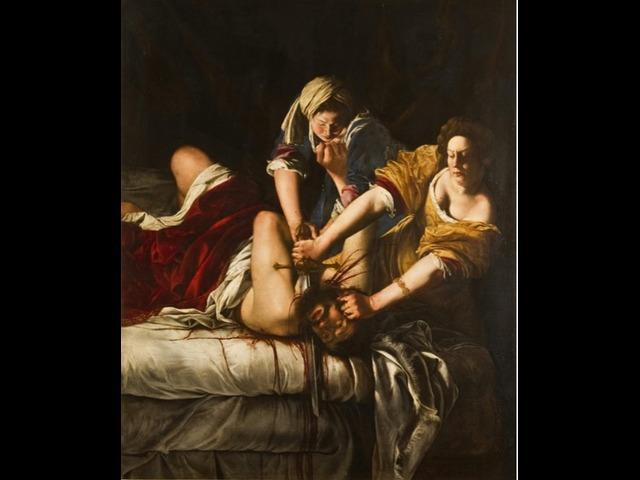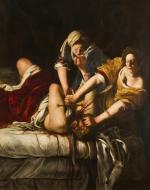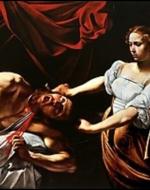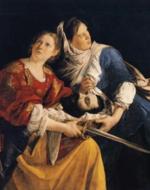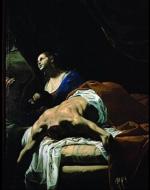Created by Riley George on Sun, 03/03/2024 - 18:21
Description:
Introduction
Through comparison of male and female-created artworks of Judith beheading her rapist, Holofernes, male ideology of women's emotional capacity being limited to that of embodying good, moral centers with demure and gentle dispositions can be observed through the differing depictions of Judith, her maidservant, and Holofernes. Even in the event of a woman beheading her rapist, male artists work to frame it in a light that fits within their patriarchal ideologies. In Artemesia Gentileschi's Judith Slaying Holofernes, she rejects the limited ideas of women's emotion and capabilities reflected in the works created by her father, Orazio Gentileschi, her father's idol, Caravaggio, and other male Baroque period artist Mattia Preti. For Artemesia, a victim of rape, seeing through another women's eyes was to see through her own--this personal experience resonating with the female collective and asserting, validating, and empowering the female gaze. The discrepancies between the widely accepted and shared beliefs in men's notions on women's emotion and capabilities when contrasted to women's emotions and capabilities as defined by themselves can be seen in these depictions of Judith beheading her rapist and their relations to the literary works "Xantippe" by Levy and "Porphyria's Lover" by Browning. Though the depiction of female rage in Levy's "Xantippe" is not so graphic as the gory depiction of murder in Artemesia's work on female rage and vengeance, it lends power to the violent capacity of women through loaded imagery, "...with angry hands I flung / The skin upon the marble, where it lay / Sprouting red hills and fountains on the white / ... / White garment stained to redness--beating heart / Flooded with all the flowing tide of hopes" (214-220). Browning's "Porphyria's Lover" reveals women's common positioning as the object of violence, rather than the agent of violence, and depicts an event of rape and subsequent murder that acts as a foil to Judith's beheading of Holofernes. This gallery calls to question who the true authority on the emotions and capabilities of women is: the women who live it or the men who observe it?
Images
Fig. 1. Artemesia Gentileschi's Judith Slaying Holofernes (1620)
Gentileschi, Artemesia. Judith Slaying Holofernes. 1620, Uffuzi Gallery, Florence.
Judith Slaying Holofernes by Artemesia Gentileschi was painted in response to Caravaggio's depiction of the same scene. Here, Judith and her maidservant are pictured as strong and decisive, "her face has an expression of determination and concentration. Her entire physical set is that of someone efficient...who knows and understands precisely what she is doing" (Pointon 3). The women are working together with deadly force, showing Holofernes pinned onto his back, "on a heap of blood-stained linen, utterly at the mercy of the two women. Judith and her maid are partners, conspirators of comparable age and appearance, working as a team, active and purposive rather than resigned and aloof" (Pointon 8). This exertion of power and triumph of the women over Holofernes is not seen in the other male-created works. This display of the rage and violent capacity of women mirrors that of Xantippe in Levy's "Xantippe," "Holding the swelling wine-skin o'er my head, / With breast that heaved, and eyes and cheeks aflame, / Lit by a firy..." (173-176). Though displaying a less drastic measure of violence, the description of Xantippe's fury and the imagery of her raising the wine-skin in threat of action is reminiscent of the raising and swinging of the blade in Judith's beheading of Holofernes. In Artemesia's depiction of the murder of Judith's rapist, she presents women as a formidable force, defying societal standards of women in Judith and her maidservant's determination, anger, efficiency, and ability to exert violence and power over man.
Fig. 2. Caravaggio's Judith Beheading Holofernes (1599)
Caravaggio. Judith Beheading Holofernes. 1599, Intesa Sanpaolo, Naples.
In Caravaggio's Judith Beheading Holofernes, the focus is placed on the emotions that Holofernes is experiencing in death, depicts Judith as beautiful, timid, and unsure, and pictures her maidservant as an old, haggardly observer. Even in the brutal decapitation of her rapist, Judith is separated from the act, "by the implied central vertical of the picture space, by the division of light from dark, male from female, elegance from struggling awkwardness" (Pointon 8). This distance almost calls to question the validity in such a claim of female rage and violence, "Caravaggio's Judith would have been powerless to lift the heavy sword without the divine aid for which she called, let alone cut off the head of a struggling man," unlike Artemesia's Judith "who energetically strikes at the neck with the muscles of an experienced professional" (Pointon 8). This pointed, loaded acknowledgement of an act of women's defiance and assertion is similar to that of Plato's reaction to Xantippe's display of outrage in "Xantippe," "Saw Plato's narrow eyes and niggard mouth, / Which half did smile and hald did criticise / ... / 'Follow her mood, for here's another phase Of your black browed Xantippe..." (Levy 193-198). Caravaggio's depiction of Judith's beheading of her rapist works as an example of and contributed to patriarchal society's notions that women are not agents of violence but rather objects of violence in that they lack the drive, rage, and decisiveness of their male counterparts, emphasizing their soft beauty and perceived naturally demure nature.
Fig. 3. Orazio Gentileschi's Judith and Her Maidservant with the Head of Holofernes (1624)
Gentileschi, Orazio. Judith and Her Maidservant with the Head of Holofernes. 1624, Wadsworth Athenium Museum of Art, Hartford.
In Orazio Gentileschi's Judith and Her Maidservant with the Head of Holofernes, he avoids bloodshed and brutality in his depicting of the aftermath. Judith and her maidservant are warily watching for any inclination that those nearby (or divine observers) have become aware of their deed, both pictured as young and beautiful, their gestures and composure tender even in the act of seeing to the disposal of Holofernes's decapitated head. In contrast to Artemesia's depiction of brutal vengeance, here "the murder has been completed; the head with eyes peacefully closed nestled in soft folds of cloth, the sword is by the wide, the murderess' eyes are raised to heaven...rendering it poignant rather than brutal or violent" (Pointon 5-8). This censored violence of women as either agents or objects of male violence and contemplation of divine power or will is like that seen in Browning's "Porphyria's Lover." He describes Porphyria's agreeable disposition even in death and God's seeming lack of objection to the murder, "Her head, which droops upon it still: / The smiling rosy little head / So glad it has its utmost will / ... / And all night long we have not stirred / And yet God has not said a word!" (Browning 51-60). Orazio's work portrays male ideals of women's gentle disposition, implicates the inability to step outside of their gentle nature even in the disposal of a decapitated head, and puts the women, rather than Judith's rapist, at the judgment of God.
Fig. 4. Mattia Preti's Judith and Holofernes (1653-1656)
Preti, Mattia. Judith and Holofernes. 1653-1656, Museo di Capodimonte, Naples.
Mattia Preti's Judith and Holofernes, like Orazio's work, depicts the aftermath of the beheading. He follows Artemesia's depiction "in the positioning of the body on the bed with its horizontal lines of mattresses and dripping gore," but "it is instructive to observe what a difference is made by changing the position of the arms of the (now headless) Holofernes and by replacing the two midwives in the foreground by the single devout and passive female figure in the background" (Pointon 16). Whereas Holofernes's arms in Artemesia's work are pointed upward in obvious struggle, here they are cast downward as if he were facedown and already at a disadvantage, likely pointing at a women's (being 'gentle, caring, and moral') inability to look into the face of her victim and biological inferiority of strength necessitating advantage to commit the murder. This male expectation of women as good, moral centers can be seen in "Porphyria's Lover," describing the narrator's perfect woman, "That moment she was mine, mine, fair / Perfectly pure and good" (Browning 44-45). Judith is shown here afterward as sorrowful, her holding of the head reminiscent of the cradling of a baby. The inferiority of strength insinuated here, both physical and emotional, is also reflected in Browning's work, "Too weak, for all her heart's endeavor" (22). Preti's work displays and contributes to male ideology through depicting women's limited capacity as being good, moral centers in Judith's sorrowful gaze in the face of her rapist's murder and highlights women's 'inherent' inferiority through attributing Judith's ability to overpower Holofernes to him being at a disadvantage.
Works Cited
Browning, Robert. "Porphyria's Lover." 1836.
Levy, Amy. "Xantippe." 1880.
Pointon, Marcia. "Artemesia Gentileschi's 'The Murder of Holofernes.'" American Imago, vol. 38, no. 4, 1981, pp. 343-67. JSTOR, http://www.jstor.org/stable/26303770. Accessed 3 Mar. 2024.

